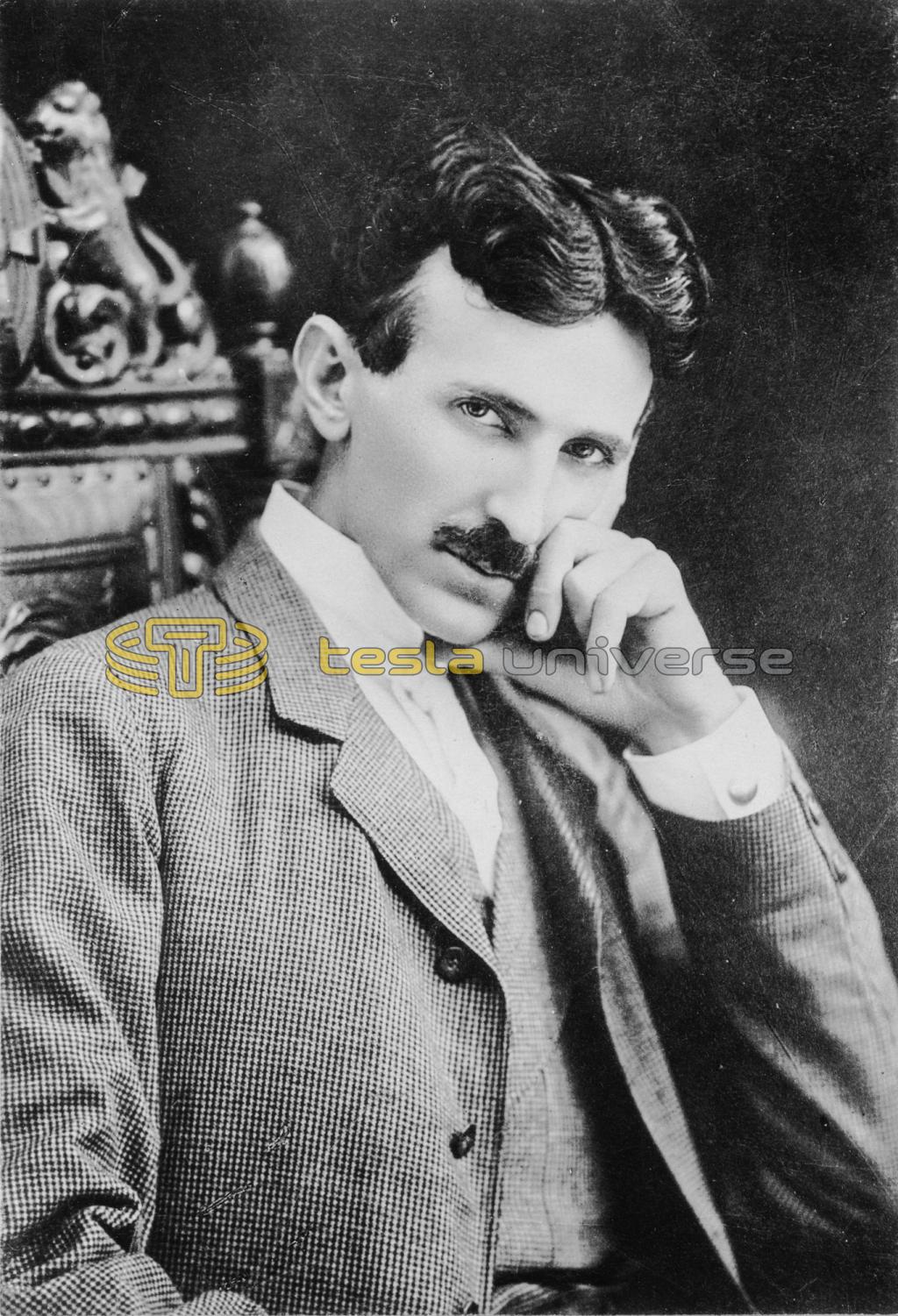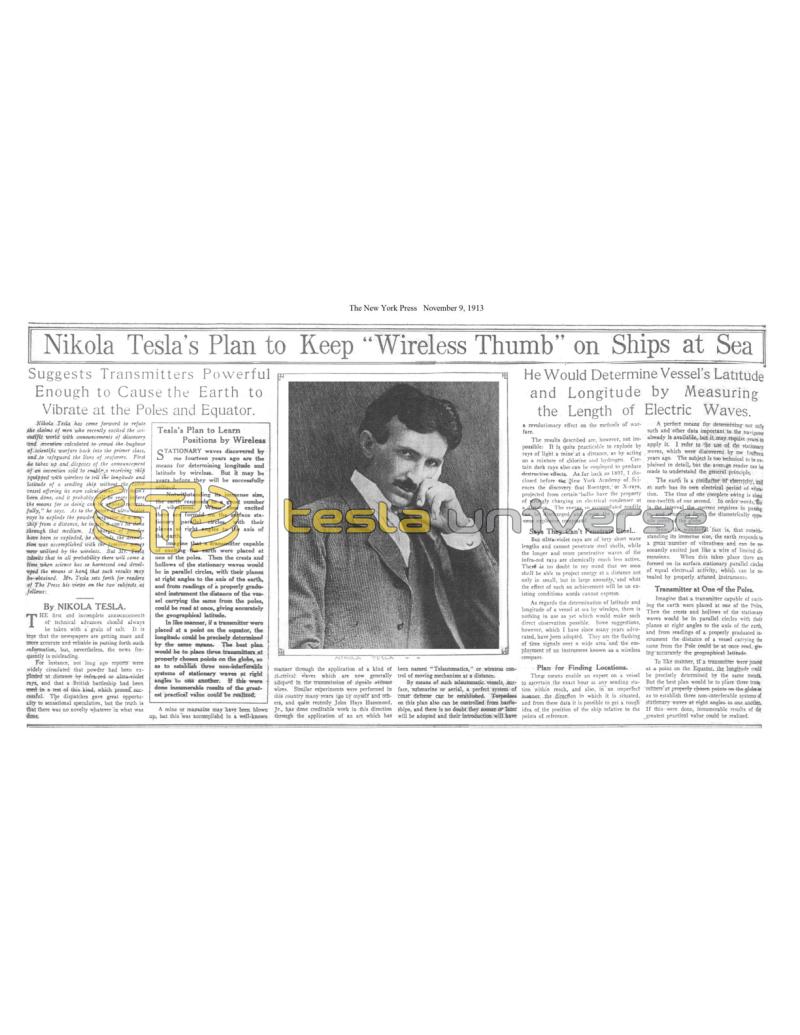
Nikola Tesla Articles
Nikola Tesla's Plan to Keep "Wireless Thumb" on Ships at Sea
Suggests Transmitters Powerful Enough to Cause the Earth to Vibrate at the Poles and Equator.
He would Determine Vessel’s Latitude and Longitude by Measuring the Length of Electric Waves.
Nikola Tesla has come forward to refute the claims of men who recently excited the scientific world with announcements of discovery and invention calculated to crowd the bugbear of scientific warfare back into the primer class, and to safeguard the lives of seafarers. First he takes up and disposes of the announcement of an invention said to enable a receiving ship equipped with wireless to tell the longitude and latitude of a sending ship without the latter vessel offering its own calculations. “It hasn’t been done, and it probably will be years before the means for so doing can be applied successfully,” he says. As to the power of ultra-violet rays to explode the powder magazine of a warship from a distance, he insists it can’t be done through that medium. If charges of powder have been so exploded, he contends, the detonation was accomplished with the familiar waves now utilized by the wireless. But Mr. Tesla admits that in all probability there will come a time when science has so harnessed and developed the means at hand that such results may be obtained. Mr. Tesla sets forth for readers of The Press his views on the two subjects as follows:
The first and incomplete announcements of technical advances should always be taken with a grain of salt. It is true that the newspapers are getting more and more accurate and reliable in putting forth such information, but, nevertheless, the news frequently is misleading.
For instance, not long ago reports widely circulated that powder had been exploded at distance by infra-red or ultra-violet rays, and that a British battleship had been used in a test of this kind, which proved successful. The dispatches gave great opportunity to sensational speculation, but the truth is that there was no novelty whatever in what was done.
Tesla's Plan to Learn Positions by Wireless
Stationary waves discovered by me years ago are the means for determining longitude and latitude by wireless. But it may be years before they will be successfully utilized.
Notwithstanding its immense size, the earth responds to a great number of vibrations. When thus excited there are formed on the surface stationary parallel circles, with their planes at right angles to the axis of the earth.
Imagine that a transmitter capable of exciting the earth were placed at one of the poles. Then the crests and hollows of the stationary waves would be in parallel circles, with their planes at right angles to the axis of the earth, and from readings of a properly graduated instrument the distance of the vessel carrying the same from the poles, could be read at once, giving accurately the geographical latitude.
In like manner, if a transmitter were placed at a point on the equator, the longitude could be precisely determined by the same means. The best plan would be to place three transmitters at properly chosen points on the globe, so as to establish three non-interferable systems of stationary waves at right angles to one another. If this were done innumerable results of the greatest practical value could be realized.
A mine or magazine may have been blown up, but this was accomplished in a well-known manner through the application of a kind of electrical waves which are now generally adopted in the transmission of signals without wires. Similar experiments were performed in this country many years ago by myself and others, and quite recently John Hays Hammond, Jr., has done credible work in this direction through the application of an art which has been named “Telautomatics,” or wireless control of moving mechanism at a distance.
By means of such telautomatic vessels, surface, and submarine or aerial, a perfect system of coast defense can be established. Torpedoes on this plan also can be controlled from battleships, and there is no doubt they sooner or later will be adopted and their introduction will have a revolutionary effect on the methods of warfare.
The results described are, however, not impossible. It is quite practicable to explode by rays of light a mine at a distance, as by acting, on a mixture of chlorine and hydrogen. Certain dark rays also can be employed to produce destructive effects. As far back as 1897, I disclosed before the New York Academy of Sciences the discovery that Roentgen, or X-rays, projected from certain bulbs have the property of strongly charging an electrical condenser at a distance. The energy so accumulated readily can be discharged and cause the ignition of some explosive compound.
Says They Can’t Penetrate Steel.
But ultra-violet rays are of very short wave lengths and cannot penetrate steel shells, while the longer and more penetrative waves of the infra-red rays are chemically much less active. There is no doubt in my mind that we soon shall be able to project energy at a distance not only in small, but in large amounts, and what the effect of such an achievement will be on existing conditions, words cannot express.
As regards the determination of latitude and longitude of a vessel at sea by wireless, there is nothing in use as yet which would make such direct observation possible. Some suggestions, however, which I have since many years advocated, have been adopted. They are the flashing of time signals over a wide area and the employment of an instrument known as a wireless compass.
Plan for Finding Locations.
These means enable an expert on a vessel to ascertain the exact hour at any sending station within reach, and also, in an imperfect manner, the direction in which it is situated, and from these data it is possible to get a rough idea of the position of the ship relative to the points of reference.
A perfect means for determining not only such and other data important to the navigator already is available, but it may require years to apply it. I refer to the use of the stationary waves, which were discovered by me fourteen years ago. The subject is too technical to be explained in detail, but the average reader can be made to understand the general principle.
The earth is a conductor of electricity, and as such has its own electrical period of vibration. The time of one complete swing is about one-twelfth of a second. In other words, this is the interval the current requires in passing to, and returning from, the diametrically opposite point of the globe.
Now, the wonderful fact is, that notwithstanding its immense size, the earth responds to a great number of vibrations and can be resonantly excited just like a wire of limited dimensions. When this takes place there are formed on its surface stationary parallel circles of equal electrical activity, which can be revealed by properly attuned instruments.
Transmitter at One of the Poles.
Imagine that a transmitter capable of exciting the earth were placed at one of the Poles. Then the crests and hollows of the stationary waves would be in parallel circles with their planes at right angles to the axis of the earth, and from readings of a properly graduated instrument the distance of a vessel carrying the same from the Pole could be at once read, giving accurately the geographical latitude.
In like manner, if a transmitter were placed at a point on the Equator, the longitude could be precisely determined by the same means. But the best plan would be to place three transmitters at properly chosen points on the globe so as to establish three non-interferable systems of stationary waves at right angles to one another. If this were done, innumerable results of the greatest practical value could be realized.

